
Blackburn Aircraft Limited was a British aircraft manufacturer from 1914 to 1963 that concentrated mainly on naval and maritime aircraft.
The Aircraft Manufacturing Company Limited (Airco) was an early British aircraft manufacturer. Established during 1912, it grew rapidly during the First World War, referring to itself as the largest aircraft company in the world by 1918.

Avro was a British aircraft manufacturer. Its designs include the Avro 504, used as a trainer in the First World War, the Avro Lancaster, one of the pre-eminent bombers of the Second World War, and the delta wing Avro Vulcan, a stalwart of the Cold War.
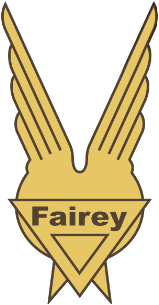
The Fairey Aviation Company Limited was a British aircraft manufacturer of the first half of the 20th century based in Hayes in Middlesex and Heaton Chapel and RAF Ringway in Cheshire that designed important military aircraft, including the Fairey III family, the Swordfish, Firefly, and Gannet. It had a strong presence in the supply of naval aircraft, and also built bombers for the RAF.
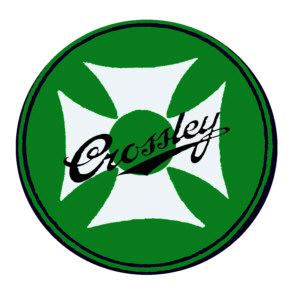
Crossley Motors was an English motor vehicle manufacturer based in Manchester, England. It produced approximately 19,000 cars from 1904 until 1938, 5,500 buses from 1926 until 1958, and 21,000 goods and military vehicles from 1914 to 1945.
Heaton Chapel is an area in the northern part of Stockport, Greater Manchester, England. Within the boundaries of the historic county of Lancashire, it borders the Manchester districts of Levenshulme to the north, the Stockport districts of Heaton Moor to the west, Reddish and Heaton Norris to the east, and Heaton Mersey to the west and south. Heaton Chapel and its neighbouring areas are known collectively as the Four Heatons.

Willys Overland Crossley was a company jointly owned by Crossley Motors and Willys-Overland. They had factories in Stockport, England; Berlin, Germany; and Antwerp, Belgium. The company was formed in 1919 and continued until 1934. They manufactured cars, buses and trucks.
Royal Air Force Ringway or more simply RAF Ringway is a former Royal Air Force satellite station in Ringway, Cheshire, England, near Manchester. It was operational from 1939 until 1957. The site of the station is now occupied by Manchester Airport.

The Fairey Spearfish was a British carrier-based, single-engined, torpedo bomber/dive bomber that was ordered from Fairey Aviation for the Fleet Air Arm during World War II. Designed during the war, the prototype did not fly until July 1945. Much larger than earlier naval bombers, it was designed for use aboard the large Malta-class aircraft carriers that were cancelled after the war and was itself cancelled thereafter. Seven prototypes were ordered, but only five were built, of which four actually flew. They were mostly used for experimental work until the last aircraft was scrapped in 1952.
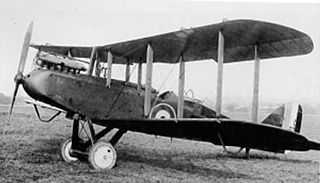
The Airco DH.9 – also known after 1920 as the de Havilland DH.9 – is a British single-engined biplane bomber that was developed and deployed during the First World War.
The Fairey Band is a brass band based in Heaton Chapel in Stockport, Greater Manchester. The band has achieved fame in modern music circles with its appearances playing Acid Brass although they still play traditional brass band music and participate each year in the Whit Friday Brass Band contests.
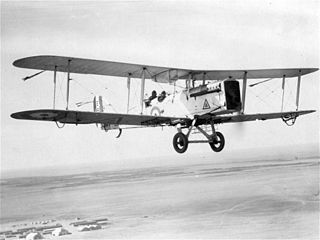
The Airco DH.9A is a British single-engined light bomber that was designed and first used shortly before the end of the First World War. It was a development of the unsuccessful Airco DH.9 bomber, featuring a strengthened structure and, crucially, replacing the under-powered and unreliable inline 6-cylinder Siddeley Puma engine of the DH.9 with the American V-12 Liberty engine.

Alexandra Park Aerodrome was the second purpose-built aerodrome in the Manchester area in England. The site was chosen by the War Department in 1917 because of its open agricultural nature, and lay between the neighbouring districts of Fallowfield, Chorlton-cum-Hardy, Whalley Range, Withington and West Didsbury, at the junction of Princess Road and Mauldeth Road West, three miles south of Manchester's city centre: the land was owned by the Egerton Estate. The aerodrome's brief existence is commemorated on a plaque in the sports pavilion at Hough End Playing Fields, which now occupy part of the site. A commemorative plaque was unveiled on 7 July 2007 to mark the 90th anniversary of the aerodrome and is located in the grounds of No. 184 Squadron, Air Cadets, in Hough End Crescent.

The Airco DH.5 was a British First World War single-seat biplane fighter aircraft. It was designed and manufactured at British aviation company Airco. Development was led by aircraft designer Geoffrey de Havilland as a replacement for the obsolete Airco DH.2.

The Airco DH.10 Amiens was a twin-engined heavy bomber designed and produced by the British aircraft manufacturer Airco. It performed the first nighttime air mail service in the world on 14-15 May 1919.

No. 613 Squadron was an Auxiliary Air Force later Royal Auxiliary Air Force squadron formed on 1 February 1939 at the then new municipal airport at Ringway, nine miles south of Manchester. The squadron served at first in the army cooperation role, and later during the Second World War became a tactical bomber unit. After the war the squadron reformed as a fighter unit and as such flew until its last disbandment in March 1957.
Hatfield Aerodrome was a private airfield and aircraft factory located in the English town of Hatfield in Hertfordshire from 1930 until its closure and redevelopment in the 1990s.
Lord John Gregson, Baron Gregson of Stockport DL HonFREng was a British politician, and a member of the Labour Party.
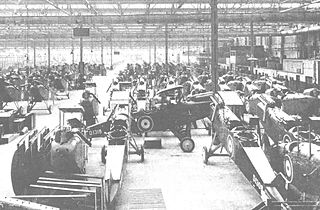
During World War I, the importance of military control of the air became evident. The United Kingdom government therefore sought to significantly increase aircraft manufacturing capacity. In 1917 the Ministry of Munitions, then headed by Winston Churchill, commissioned the construction of National Aircraft Factories to significantly boost the rate and scale of production.

Kingsbury Aviation was an English aircraft manufacturer and engineering business based at Kingsbury Aerodrome, Kingsbury, London from 1916.














